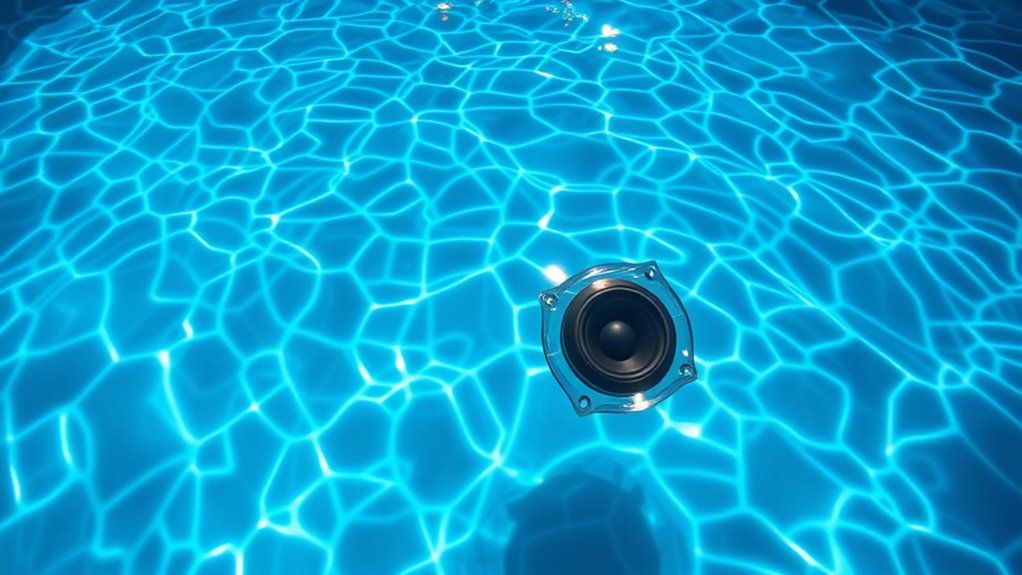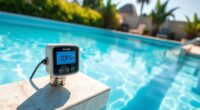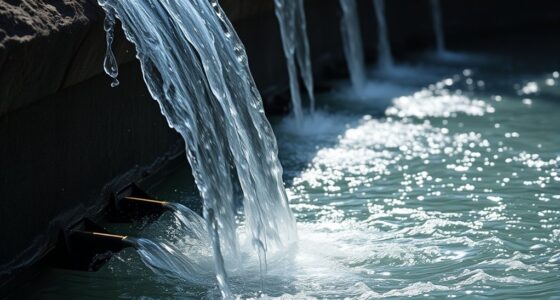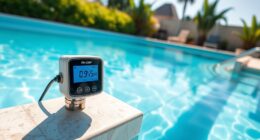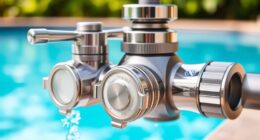Underwater speakers send sound through water, which transmits vibrations faster and farther than air due to its density and elasticity. You’ll notice that lower frequencies travel longer distances with less loss, while higher frequencies are absorbed quickly. Designing effective underwater speakers involves waterproof materials, specialized transducers, and strategic placement to reduce attenuation. If you keep exploring, you’ll discover how different technologies overcome these challenges and enhance underwater sound experiences even more.
Key Takeaways
- Water’s density and elasticity allow sound waves to travel faster and farther compared to air.
- Higher frequencies attenuate quickly, limiting their range, while lower frequencies penetrate deeper and cover larger areas.
- Underwater speakers use waterproof enclosures and specialized transducers to convert electrical signals into sound waves.
- Proper placement and frequency selection enhance sound coverage and clarity in a pool environment.
- Water’s absorption and reflection properties influence how sound propagates, affecting volume, directionality, and reach.
How Sound Travels in Water vs. Air
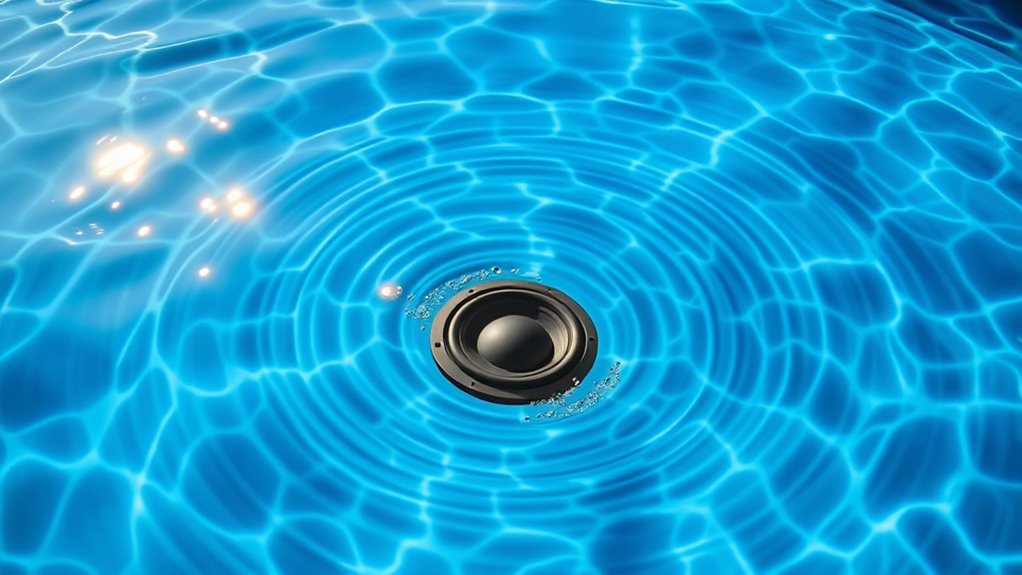
Sound travels differently in water than in air because water is much denser and more elastic. This means that when you produce a sound underwater, it moves faster and farther than it would in air. The molecules in water are tightly packed, so they transmit vibrations more efficiently. As a result, sound waves don’t weaken as quickly over distance. You’ll notice that underwater sounds can be heard from much farther away than in air. Additionally, water’s elasticity allows sound waves to bounce and reflect more readily, creating complex sound patterns. This property is why underwater speakers can project audio over long distances, making them ideal for communication, navigation, and entertainment beneath the surface. The high transmission efficiency of water also means that sound can carry through large bodies of water with minimal loss, enabling effective underwater communication over vast areas.
The Role of Frequency and Wavelength in Underwater Sound
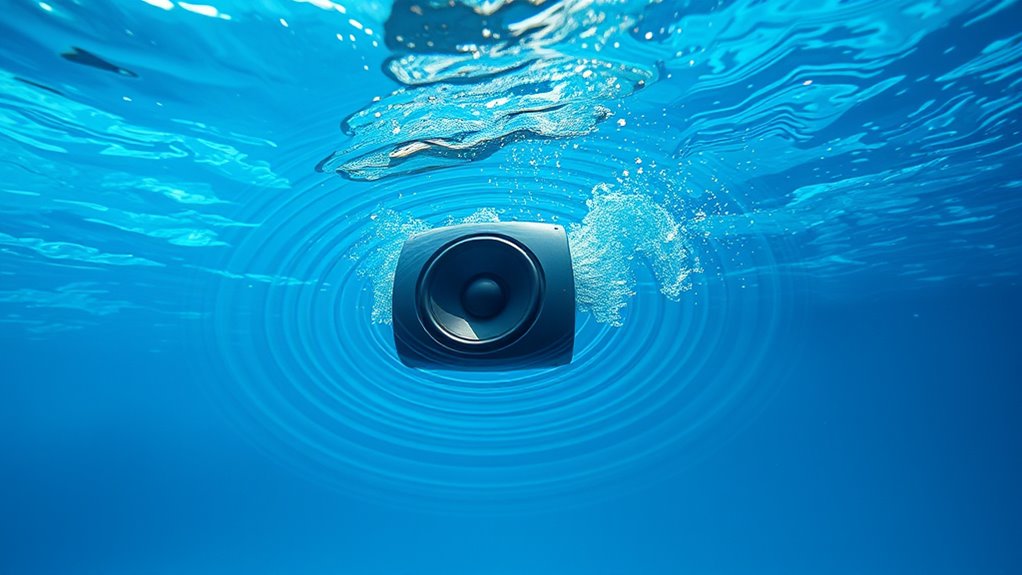
Understanding how frequency and wavelength affect underwater sound helps you see why certain signals travel farther than others. Higher frequencies have shorter wavelengths and tend to dissipate quickly, while lower frequencies can penetrate deeper. Recognizing these differences is key to optimizing underwater sound transmission for your needs. Additionally, choosing the right sound frequencies can be influenced by technological advancements in acoustic devices, which improve signal clarity and range in aquatic environments.
Wavelength and Speed
Have you ever wondered how the frequency of an underwater sound wave influences its wavelength and speed? When sound travels in water, higher frequencies result in shorter wavelengths, while lower frequencies produce longer ones. The speed of sound in water remains relatively constant, around 1,480 meters per second, but it can vary slightly based on temperature, salinity, and pressure. Understanding this relationship helps you grasp how sound waves behave underwater. Ford Tuning techniques can also optimize acoustic performance in specialized underwater equipment.
Frequency Impact on Sound
The frequency of an underwater sound wave directly influences how you perceive and utilize that sound. Higher frequencies produce shorter wavelengths, making the sound more localized and easier to pinpoint. This is useful for tasks like sonar or underwater communication where precision matters. Conversely, lower frequencies have longer wavelengths, allowing sound to travel farther with less attenuation. This makes low-frequency sounds ideal for long-distance communication or detecting distant objects. The frequency also affects how sound interacts with water and obstacles; high-frequency sounds tend to be absorbed more quickly, reducing their range. Additionally, sound absorption varies with frequency, impacting how far sound can effectively travel. Understanding how frequency impacts sound helps you optimize underwater speaker placement, ensuring your signals reach the desired distance and clarity. By selecting the right frequency, you control sound clarity, reach, and effectiveness underwater.
Sound Penetration in Water
Frequency and wavelength play essential roles in how sound penetrates water, with each influencing the distance and clarity of the signal. Higher frequencies tend to be absorbed quickly, limiting their range, while lower frequencies travel farther with less energy loss. Wavelength also affects how sound interacts with objects and boundaries in the water, impacting how well it propagates. Additionally, water’s sound absorption properties vary with frequency, affecting sound transmission over distance. Wavelength determines how sound waves reflect and scatter in the water. Understanding these factors helps you choose the right sound settings for effective underwater communication, ensuring your message reaches its intended audience clearly and efficiently.
Designing Speakers for Aquatic Environments
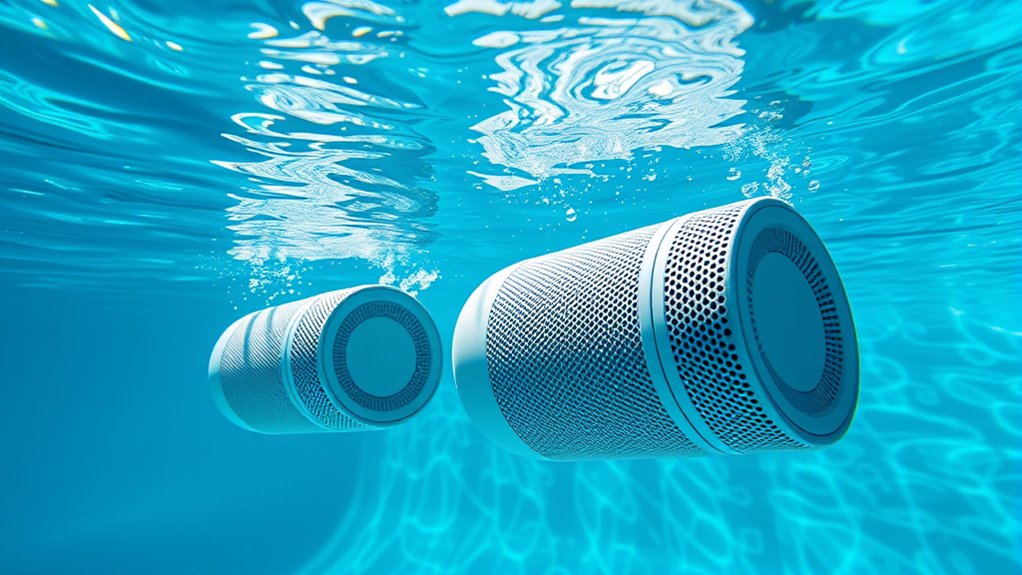
Ever wondered how underwater speakers are built to withstand the intense conditions of aquatic environments? They’re designed with waterproof enclosures, corrosion-resistant materials, and sealed electronics to prevent water damage. Durability is key, so engineers choose materials like stainless steel or specialized plastics that endure pressure and corrosion. To optimize sound transmission, the shape and size of the enclosure are carefully crafted. Here’s a quick look at some design features:
| Feature | Purpose |
|---|---|
| Waterproof casing | Protects electronics from water ingress |
| Pressure-resistant materials | Handles deep water pressure |
| Acoustic sealing | Prevents sound leakage and water entry |
| Corrosion-resistant coating | Extends lifespan in saltwater |
| Compact, sturdy design | Ensures durability and sound quality |
Additionally, understanding the importance of sound physics helps engineers enhance performance in underwater environments. These elements ensure your underwater speaker performs reliably, no matter the environment.
Transducer Technology and Its Importance
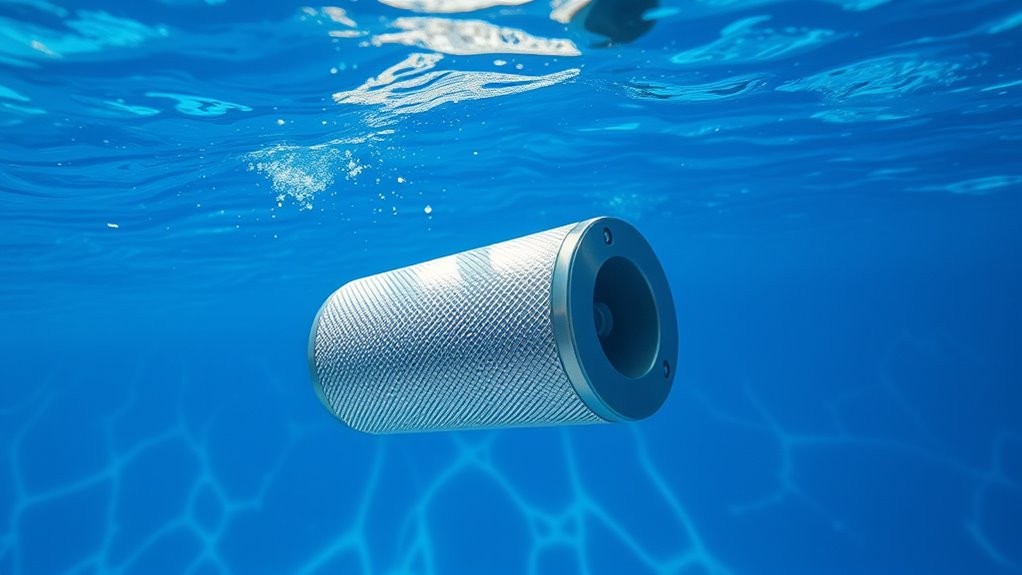
Understanding how underwater speakers produce sound begins with examining transducer technology. Transducers convert electrical signals into sound waves, making them essential for underwater audio. The key to effective sound transmission lies in selecting the right transducer type, such as piezoelectric or dynamic. These devices must efficiently transfer energy into water, overcoming challenges like impedance mismatch. High-quality transducers ensure clear, powerful sound delivery in pools or aquatic environments. Their design impacts sound quality, coverage, and durability. Choosing the proper transducer involves understanding material properties, size, and mounting methods. Kia Tuning innovations offer insights into specialized components that can improve transducer performance in aquatic settings.
- Efficient energy conversion is vital for loud, clear sound
- Material durability affects lifespan in water
- Proper mounting ensures maximum sound coverage
Overcoming Challenges of Sound Attenuation in Water

Water’s density absorbs and weakens sound waves, making it hard to transmit signals over long distances. This attenuation limits how far your audio can travel underwater. To improve signal transmission, you need to address these challenges directly and develop effective solutions. Incorporating specialized sound transmission technologies can significantly enhance underwater audio performance by counteracting the natural attenuation effects.
Water’s Density Diminishes Sound
Have you ever wondered why sound travels so differently underwater compared to in the air? The main reason is water’s density. Water is much denser than air, which affects how sound waves move through it. This density causes sound to spread out and lose energy faster, making it harder to transmit over long distances. To overcome this, underwater speakers must generate stronger signals. You should also consider:
- The increased energy needed to push sound through dense water
- How water’s density causes higher absorption of sound
- The importance of designing speakers that compensate for energy loss
- Wave Propagation Dynamics explains how sound waves behave differently in dense mediums like water.
Attenuation Limits Audio Range
Because sound waves weaken as they travel through dense water, attenuation considerably limits how far audio signals can reach underwater. The energy of sound diminishes over distance, especially at higher frequencies, making long-range transmission challenging. This means your underwater speaker’s sound might be loud nearby but quickly fades out as you move further away. Water’s absorption of sound depends on factors like frequency, temperature, and pressure, all contributing to signal loss. To ensure your audio reaches a desired distance, you need to account for this natural attenuation. Simply increasing volume isn’t enough; understanding how water absorbs specific frequencies helps optimize speaker placement and design. Recognizing these limits allows you to better plan your underwater sound system for effective communication or entertainment. Additionally, knowing the sound physics involved can help you select the appropriate equipment for your needs.
Enhancing Signal Transmission
To effectively overcome sound attenuation underwater, you need to employ strategies that enhance signal transmission and guarantee your audio reaches the desired audience. One approach is to optimize speaker placement, ensuring they’re positioned to minimize sound loss. Using higher power levels can also improve signal strength, but be mindful of safety and water quality. Additionally, selecting the right frequency is vital—lower frequencies travel farther with less attenuation. To maximize effectiveness:
- Use directional speakers to focus sound toward your target area
- Increase power output within safe limits
- Choose lower frequencies for broader coverage
Implementing these strategies helps combat water’s natural sound dampening, ensuring your message remains clear and audible across the pool.
Applications of Underwater Speakers in Different Settings
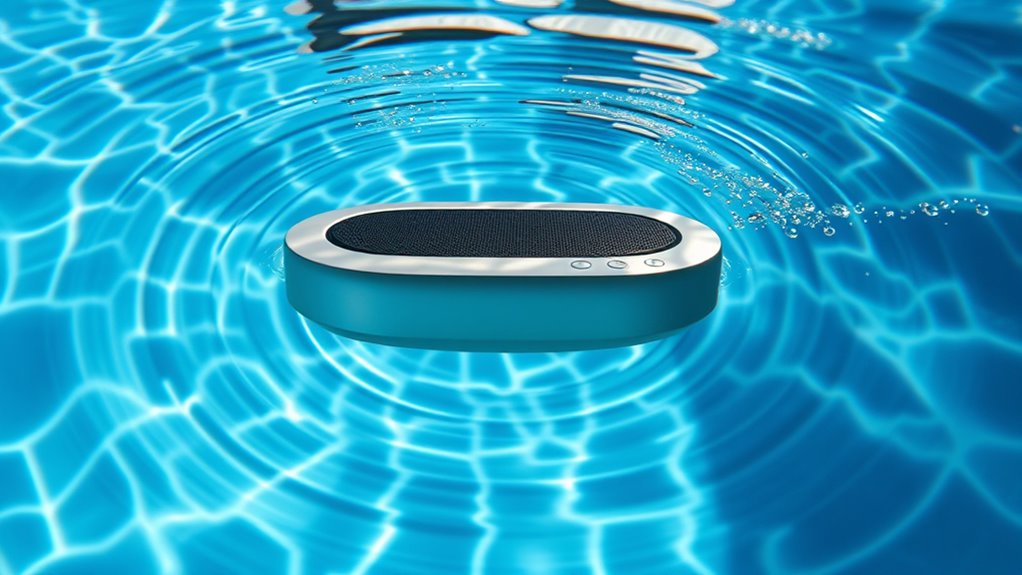
Underwater speakers are versatile tools that find applications across a variety of settings, from scientific research to recreational activities. In research, they help study marine life behaviors and communicate with underwater sensors. For entertainment, they’re used in pools, aquariums, and underwater theaters to create immersive experiences. They also assist in diver training by transmitting clear instructions underwater. Here’s a quick look at some settings:
| Setting | Purpose |
|---|---|
| Marine Research | Studying fish communication and ocean conditions |
| Recreational Pools | Playing music or narrating guided tours |
| Aquariums | Enhancing visitor experience with sound |
| Underwater theaters | Delivering sound for underwater performances |
These applications make underwater speakers essential tools across diverse environments.
Future Innovations in Underwater Audio Technology
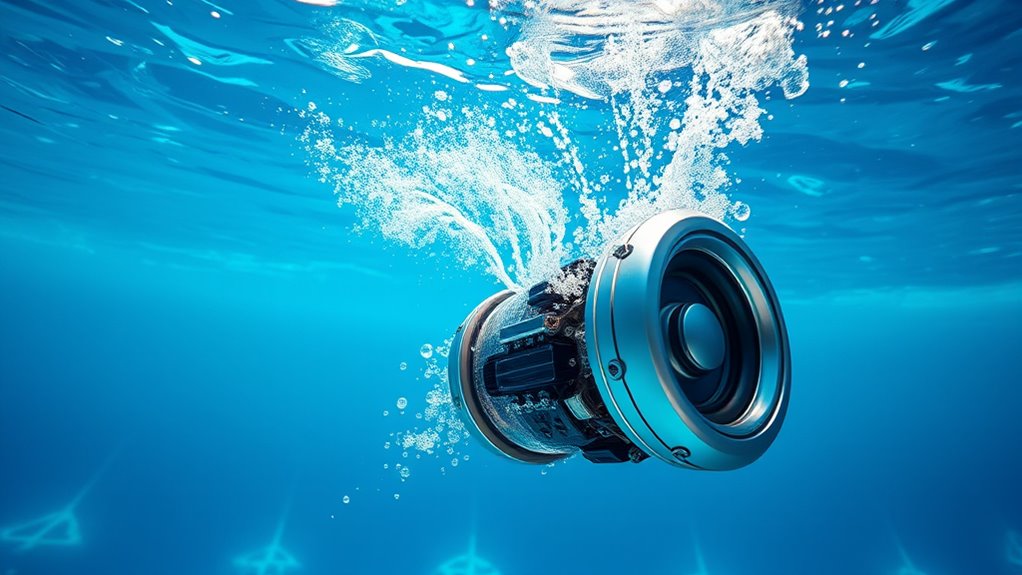
Advancements in underwater audio technology promise to revolutionize how you communicate and explore beneath the waves. Researchers are developing more powerful, clearer, and more efficient speakers that can operate at greater depths and over longer distances. Innovations include miniaturized devices for personal use, enhanced signal processing for cleaner sound, and materials that better transmit sound through water’s dense medium. These improvements will enable more accurate underwater mapping, improved marine research, and immersive experiences for divers and explorers.
Underwater audio tech advances enhance communication, mapping, and exploration with clearer, more powerful, and durable sound devices.
- Smaller, portable underwater speakers for personal use
- AI-powered sound processing for clearer communication
- Durable materials that withstand high pressure and corrosion
Frequently Asked Questions
How Does Temperature Affect Underwater Sound Propagation?
You’ll notice that higher water temperatures make sound travel faster and farther underwater. That’s because warmer water decreases the density and increases the elasticity of the water, allowing sound waves to move more efficiently. Conversely, cooler water slows down sound propagation. So, if you’re using underwater speakers, keep in mind that temperature changes can influence how far and clearly your sound reaches, impacting your overall experience.
What Materials Are Best for Underwater Speaker Enclosures?
You should choose materials like acrylic, stainless steel, or high-density plastics for underwater speaker enclosures. These materials resist corrosion, withstand pressure, and transmit sound effectively. Acrylic offers clear sound transmission and is durable, while stainless steel provides strength and longevity. High-density plastics are lightweight, cost-effective, and resistant to water damage. By selecting these materials, you guarantee your underwater speakers perform reliably and deliver high-quality sound in aquatic environments.
How Do Underwater Currents Impact Sound Transmission?
Underwater currents can substantially impact sound transmission by creating turbulence that disrupts the path of sound waves. As you operate underwater speakers, you’ll notice that strong currents may weaken sound clarity or cause distortion. They can also cause the sound waves to scatter, reducing their range. To maintain ideal sound quality, you should position speakers away from strong currents and consider using enclosures that help stabilize sound transmission.
Can Underwater Speakers Be Used Simultaneously With Sonar Systems?
Yes, underwater speakers can work simultaneously with sonar systems, but you need to orchestrate their signals carefully. Think of it like a duet—each instrument must stay in harmony to avoid jarring noise. By adjusting frequencies and timing, you prevent interference, allowing both to perform seamlessly. This coordination ensures clear communication and accurate sonar detection, turning your underwater environment into a symphony of sound that works in perfect tandem.
What Are the Safety Considerations for Underwater Sound Levels?
You should always monitor underwater sound levels to prevent hearing damage or stress to aquatic life. Keep sound intensity below safety thresholds, especially in recreational or research settings. Use appropriate equipment and limit exposure time to reduce risks. Regularly check and maintain your underwater audio devices. If you’re unsure, consult safety guidelines or experts to ensure sound levels stay within safe limits, safeguarding both people and marine environments.
Conclusion
While sound travels effortlessly underwater, reaching distant ears with clarity, it can also fade into silence if not properly designed. You feel the power of clear, immersive audio in a pool, yet recognize the challenges of attenuation and distortion. This juxtaposition reminds you that, with innovation and understanding, you can harness underwater sound’s potential, turning silent depths into vibrant worlds of connection, discovery, and emotion—proof that even in silence, sound can truly resonate.
